The Staples PP Nonwovens Market is estimated to be valued at USD 9.0 billion in 2025 and is projected to reach USD 15.4 billion by 2035, registering a compound annual growth rate (CAGR) of 5.5% over the forecast period. This growth, supported by a steady CAGR of 5.5%, is driven by increasing demand for nonwoven materials in applications such as hygiene products, medical textiles, automotive, and filtration.
During the first five years (2025 to 2030), the market is expected to grow from USD 9 billion to USD 11.8 billion, adding USD 2.8 billion, which accounts for 43.8% of the total incremental growth, with a 5-year multiplier of 1.31x. The second phase (2030 to 2035) contributes USD 3.6 billion, representing 56.2% of incremental growth, reflecting stronger momentum driven by increased adoption in sustainable packaging, medical, and agricultural sectors.
Annual increments grow from USD 0.5 billion in early years to USD 0.8 billion by 2035, reflecting the growing demand for eco-friendly and durable nonwoven materials. Manufacturers focusing on advanced material properties, cost efficiency, and expanding their product offerings will capture the largest share of this USD 6.4 billion opportunity.
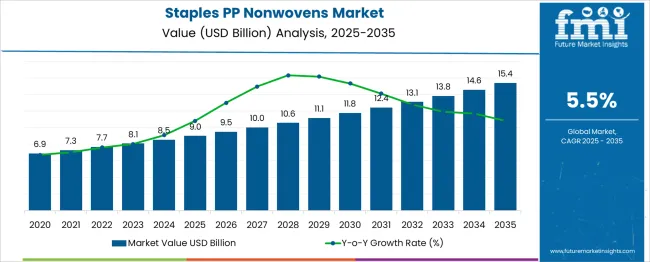
| Metric | Value |
|---|---|
| Staples PP Nonwovens Market Estimated Value in (2025 E) | USD 9.0 billion |
| Staples PP Nonwovens Market Forecast Value in (2035 F) | USD 15.4 billion |
| Forecast CAGR (2025 to 2035) | 5.5% |
The staples PP nonwovens market is undergoing significant evolution driven by rising demand for high-performance, cost-effective, and sustainable nonwoven materials across hygiene and personal care applications. Increased awareness of hygiene, aging population trends, and expanding access to disposable products in emerging economies are fueling consumption.
Technological advancements in production processes are enhancing fabric softness, strength, and absorbency while maintaining cost efficiency, further increasing adoption. Manufacturers are focusing on developing eco-friendly solutions by incorporating recyclable polypropylene and reducing energy use during production.
Future growth is expected to be supported by regulatory encouragement for biodegradable and skin-safe materials, innovation in lightweight composites, and strategic partnerships to expand global reach. Growing consumer expectations for comfort and performance are paving the way for differentiation and premiumization within this market.
The staples PP nonwovens market is segmented by application, technology, end-use industry, and geographic regions. By application of the staples, the PP nonwovens market is divided into Hygiene (diapers, sanitary napkins, adult incontinence), Medical (surgical gowns, drapes, masks), Industrial & Others (geotextiles, automotive, filtration). In terms of technology, the staples PP nonwovens market is classified into Spunbond, Spunlace, Needle-punched, and Thermal bonded.
Based on the end-use industry of the staples, the PP nonwovens market is segmented into Personal Care & Hygiene, Healthcare, Construction, Automotive, and Agriculture. Regionally, the staples PP nonwovens industry is classified into North America, Latin America, Western Europe, Eastern Europe, Balkan & Baltic Countries, Russia & Belarus, Central Asia, East Asia, South Asia & Pacific, and the Middle East & Africa.
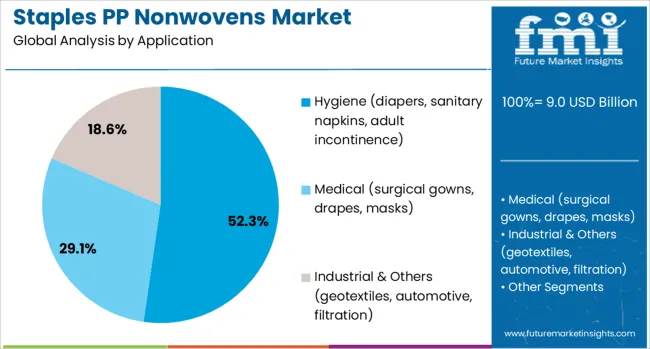
Within the application segment, hygiene encompassing diapers, sanitary napkins, and adult incontinence holds the highest share at 52.30% of the overall market in 2025. This leadership is attributed to the indispensable role of nonwovens in delivering superior absorbency, barrier protection, and comfort required for disposable hygiene products.
Consistent product innovation focusing on skin-friendliness, breathability, and reduced bulk has reinforced their widespread usage. Manufacturers have intensified investments in specialized finishes and treatments to improve fluid management and minimize irritation, aligning with consumer preferences and regulatory standards.
The segment’s prominence is further strengthened by rising birth rates in developing regions alongside increased adoption of adult incontinence products in aging populations. Such factors have collectively sustained and expanded the hygiene segment’s dominance within the market.

When analyzed by technology, spunbond accounts for 47.8% of the total market revenue in 2025, maintaining its position as the leading technology segment. This segment’s growth is driven by the efficiency and versatility of spunbond processes, which produce lightweight, durable, and uniform fabrics at high production speeds.
Continuous improvements in line speeds, polymer processing, and filament uniformity have enhanced both quality and cost-effectiveness, making spunbond the preferred choice for mass production of hygiene products. Its ability to integrate with other layers, such as meltblown in composite structures, has also expanded its applicability.
The segment has benefitted from stable raw material availability and scalability of operations, which have enabled manufacturers to meet the growing demand without compromising on performance.
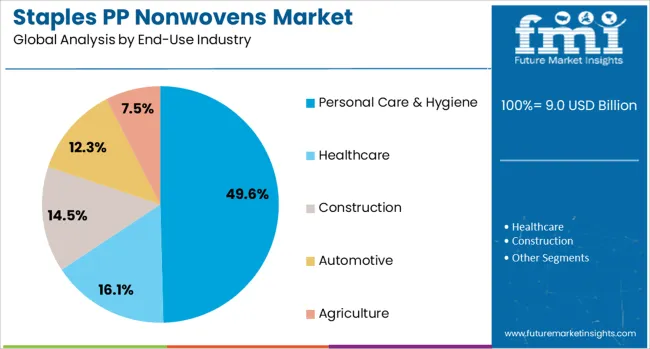
The end-use industry analysis shows personal care and hygiene commanding a leading share of 49.6% in 2025, driven by its broad and consistent demand base. This leadership stems from the industry’s reliance on nonwovens for their essential properties, including softness, liquid repellence, and structural integrity, which are critical in personal care products.
Growing consumer expectations for premium features in hygiene goods have pushed manufacturers to adopt advanced nonwoven materials to deliver differentiated products. Rising disposable incomes in developing regions and increasing awareness about hygiene have supported the expansion of this segment.
The ability of nonwovens to balance functionality, aesthetics, and cost efficiency has solidified their role as an integral material in the personal care and hygiene industry, ensuring continued market dominance.
The Staples PP nonwovens market is driven by rising demand for durable and cost-effective materials, particularly in the automotive and hygiene sectors. Opportunities in expanding applications and trends toward biodegradable nonwovens are reshaping the market. However, challenges such as fluctuating raw material prices and supply chain disruptions remain. By 2025, overcoming these obstacles through efficient supply chain management and sustainable production methods will be essential for continued growth in the market.
The Staples PP nonwovens market is experiencing growth due to the rising demand for durable, cost-effective nonwoven fabrics across industries like automotive, hygiene, and construction. Polypropylene (PP) nonwovens are widely used for their excellent strength, light weight, and versatility. As industries continue to seek affordable, high-performance materials, PP nonwovens are becoming an ideal solution. By 2025, the market will continue to benefit from this growing need for durable and versatile materials in various industrial applications.
Opportunities in the Staples PP nonwovens market are expanding with the growing use of nonwoven fabrics in the automotive and hygiene sectors. In automotive manufacturing, PP nonwovens are used for components such as interior panels, insulation, and filters. The hygiene industry is increasingly adopting these fabrics for diapers, feminine hygiene products, and adult incontinence products. By 2025, these sectors are expected to drive substantial demand, further enhancing the growth potential of PP nonwovens in industrial applications.
Emerging trends in the Staples PP nonwovens market point toward the increasing demand for biodegradable and eco-friendly alternatives. As industries face pressure to adopt more sustainable practices, biodegradable PP nonwovens made from renewable resources are gaining traction. These materials are not only environmentally friendly but also offer similar performance to conventional nonwovens. By 2025, this shift toward more sustainable PP nonwovens is expected to reshape the market, offering both ecological benefits and competitive advantages for manufacturers.
Despite growth, the Staples PP nonwovens market faces challenges from fluctuating raw material prices and supply chain disruptions. The cost of polypropylene, a key raw material, can be volatile, impacting production costs and profitability. Additionally, supply chain issues, particularly those exacerbated by global disruptions, can delay production and delivery. These factors may hinder market growth, especially in price-sensitive industries. By 2025, addressing these challenges through improved sourcing and supply chain management will be crucial for maintaining market stability.
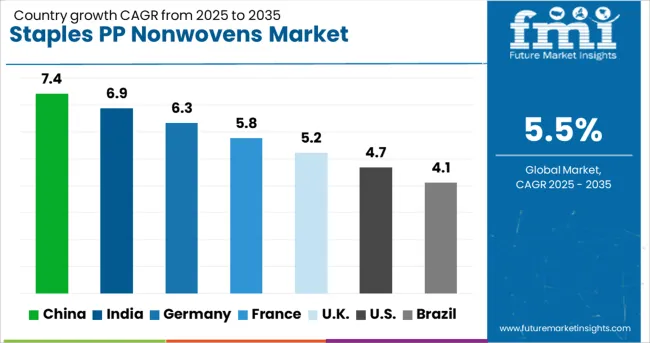
| Country | CAGR |
|---|---|
| China | 7.4% |
| India | 6.9% |
| Germany | 6.3% |
| France | 5.8% |
| UK | 5.2% |
| USA | 4.7% |
| Brazil | 4.1% |
The global staples PP nonwovens market is projected to grow at a 5.5% CAGR from 2025 to 2035. China leads with a growth rate of 7.4%, followed by India at 6.9%, and France at 5.8%. The United Kingdom records a growth rate of 5.2%, while the United States shows the slowest growth at 4.7%. These differences in growth rates are driven by factors such as increasing demand for nonwoven materials in industries such as hygiene, automotive, medical, and construction. Emerging markets like China and India are seeing higher growth due to rapid industrialization, expanding manufacturing capabilities, and the demand for eco-friendly and cost-effective solutions, while more mature markets like the USA and the UK experience steady growth driven by established applications in the hygiene and automotive sectors. This report includes insights on 40+ countries; the top markets are shown here for reference.
The staples PP nonwovens market in China is growing at a rapid pace, with a projected CAGR of 7.4%. China’s booming industrial and manufacturing sectors, particularly in hygiene products, automotive, and construction materials, are major drivers behind the increasing demand for staples PP nonwovens. The country’s push toward automation and improving production efficiency, combined with the rising demand for nonwoven materials in personal care, hygiene, and medical applications, further accelerates market growth. Additionally, China’s focus on sustainability and environmental standards is increasing the adoption of eco-friendly PP nonwoven solutions.
The staples PP nonwovens market in India is projected to grow at a CAGR of 6.9%. India’s expanding textile, hygiene, and automotive industries are key drivers of market growth. The rising demand for cost-effective and eco-friendly nonwoven materials in various applications such as diapers, personal hygiene products, and medical disposables is contributing to the market’s expansion. Additionally, the country’s growing emphasis on sustainability in manufacturing and increasing consumer demand for environmentally friendly products is boosting the adoption of staples PP nonwovens. The Indian government’s initiatives to promote manufacturing growth and enhance infrastructure also support market growth.
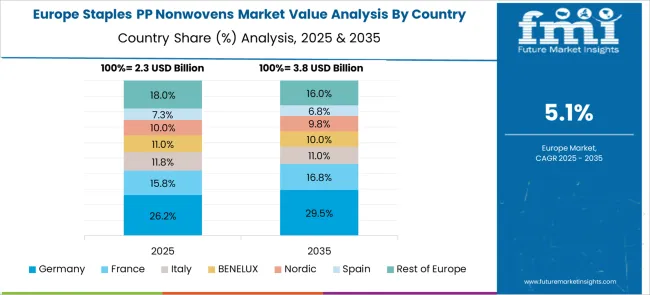
The staples PP nonwovens market in France is projected to grow at a CAGR of 5.8%. France’s established demand for nonwoven materials in the hygiene, medical, and automotive sectors continues to drive market growth. The growing focus on sustainability and the increasing need for eco-friendly nonwoven materials in consumer products are key factors contributing to market expansion. Additionally, France’s commitment to high manufacturing standards and the rising adoption of nonwoven materials in packaging, personal care, and medical applications further accelerate demand. Technological advancements in nonwoven production processes also support continued market growth.
The staples PP nonwovens market in the United Kingdom is projected to grow at a CAGR of 5.2%. The UK’s demand for PP nonwovens in hygiene products, medical supplies, and automotive applications continues to drive steady growth. The growing emphasis on reducing plastic waste, combined with the increasing consumer preference for environmentally friendly and biodegradable materials, is boosting the adoption of PP nonwovens. Additionally, the UK’s robust manufacturing sector and focus on high-quality production standards support the steady expansion of the market. The rise in demand for nonwoven materials in packaging and construction applications also contributes to growth.
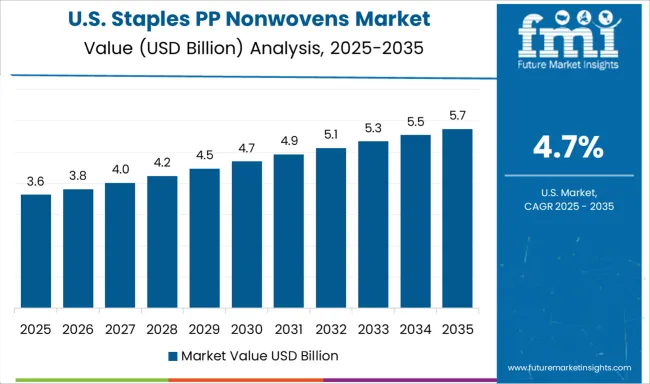
The staples PP nonwovens market in the United States is expected to grow at a CAGR of 4.7%. The USA market remains steady, driven by consistent demand from the hygiene and automotive sectors. The increasing focus on sustainability, energy efficiency, and the use of environmentally friendly nonwoven materials is contributing to steady growth. As the country moves toward reducing plastic waste and incorporating more eco-friendly materials in manufacturing, the demand for PP nonwovens is expected to continue to grow, particularly in applications such as personal care products, medical disposables, and industrial applications.

The staples polypropylene (PP) nonwovens market is dominated by Kimberly Clark, which leads with its high-quality, durable nonwoven fabrics used in a variety of applications, including hygiene products, medical supplies, and filtration. Kimberly Clark’s dominance is supported by its strong brand recognition, extensive product portfolio, and commitment to sustainability and innovation.
Key players such as ExxonMobil, Fitesa, and PEGAS maintain significant market shares by offering advanced PP nonwoven materials that provide excellent performance in hygiene and industrial applications. These companies focus on providing reliable, cost-effective nonwoven fabrics with superior strength, softness, and moisture resistance.
Emerging players like AVGOI, Mitsui, and First Quality are expanding their market presence by offering specialized nonwoven PP products for niche applications, including automotive, packaging, and medical sectors. Their strategies include improving material performance, reducing environmental impact, and offering more sustainable solutions to meet the growing demand for eco-friendly materials.
Market growth is driven by the increasing demand for nonwoven fabrics in hygiene, medical, and industrial applications, as well as the rising trend of sustainable and recyclable materials. Innovations in nonwoven technologies, including advanced bonding techniques and the development of bio-based PP nonwovens, are expected to continue shaping competitive dynamics and drive growth in the global staples PP nonwovens market.
| Item | Value |
|---|---|
| Quantitative Units | USD 9.0 Billion |
| Application | Hygiene (diapers, sanitary napkins, adult incontinence), Medical (surgical gowns, drapes, masks), and Industrial & Others (geotextiles, automotive, filtration) |
| Technology | Spunbond, Spunlace, Needle-punched, and Thermal bonded |
| End-Use Industry | Personal Care & Hygiene, Healthcare, Construction, Automotive, and Agriculture |
| Regions Covered | North America, Europe, Asia-Pacific, Latin America, Middle East & Africa |
| Country Covered | United States, Canada, Germany, France, United Kingdom, China, Japan, India, Brazil, South Africa |
| Key Companies Profiled | Kimberly Clark, PEGAS, ExxonMobil, Fitesa, AVGOI, Mitsui, First Quality, Toray, and SABIC |
| Additional Attributes | Dollar sales by staple fiber type and application, demand dynamics across hygiene, medical, and industrial sectors, regional trends in PP nonwoven adoption, innovation in biodegradable and high-performance materials, impact of regulatory standards on product safety, and emerging use cases in eco-friendly packaging and sustainable manufacturing processes. |
The global staples PP nonwovens market is estimated to be valued at USD 9.0 billion in 2025.
The market size for the staples PP nonwovens market is projected to reach USD 15.4 billion by 2035.
The staples PP nonwovens market is expected to grow at a 5.5% CAGR between 2025 and 2035.
The key product types in staples PP nonwovens market are hygiene (diapers, sanitary napkins, adult incontinence), medical (surgical gowns, drapes, masks) and industrial & others (geotextiles, automotive, filtration).
In terms of technology, spunbond segment to command 47.8% share in the staples PP nonwovens market in 2025.






Our Research Products

The "Full Research Suite" delivers actionable market intel, deep dives on markets or technologies, so clients act faster, cut risk, and unlock growth.

The Leaderboard benchmarks and ranks top vendors, classifying them as Established Leaders, Leading Challengers, or Disruptors & Challengers.

Locates where complements amplify value and substitutes erode it, forecasting net impact by horizon

We deliver granular, decision-grade intel: market sizing, 5-year forecasts, pricing, adoption, usage, revenue, and operational KPIs—plus competitor tracking, regulation, and value chains—across 60 countries broadly.

Spot the shifts before they hit your P&L. We track inflection points, adoption curves, pricing moves, and ecosystem plays to show where demand is heading, why it is changing, and what to do next across high-growth markets and disruptive tech

Real-time reads of user behavior. We track shifting priorities, perceptions of today’s and next-gen services, and provider experience, then pace how fast tech moves from trial to adoption, blending buyer, consumer, and channel inputs with social signals (#WhySwitch, #UX).

Partner with our analyst team to build a custom report designed around your business priorities. From analysing market trends to assessing competitors or crafting bespoke datasets, we tailor insights to your needs.
Supplier Intelligence
Discovery & Profiling
Capacity & Footprint
Performance & Risk
Compliance & Governance
Commercial Readiness
Who Supplies Whom
Scorecards & Shortlists
Playbooks & Docs
Category Intelligence
Definition & Scope
Demand & Use Cases
Cost Drivers
Market Structure
Supply Chain Map
Trade & Policy
Operating Norms
Deliverables
Buyer Intelligence
Account Basics
Spend & Scope
Procurement Model
Vendor Requirements
Terms & Policies
Entry Strategy
Pain Points & Triggers
Outputs
Pricing Analysis
Benchmarks
Trends
Should-Cost
Indexation
Landed Cost
Commercial Terms
Deliverables
Brand Analysis
Positioning & Value Prop
Share & Presence
Customer Evidence
Go-to-Market
Digital & Reputation
Compliance & Trust
KPIs & Gaps
Outputs
Full Research Suite comprises of:
Market outlook & trends analysis
Interviews & case studies
Strategic recommendations
Vendor profiles & capabilities analysis
5-year forecasts
8 regions and 60+ country-level data splits
Market segment data splits
12 months of continuous data updates
DELIVERED AS:
PDF EXCEL ONLINE
Textile Staples Market Size & Trends 2025 to 2035
PP Jumbo Bag Market Size and Share Forecast Outlook 2025 to 2035
PP Homopolymer Market Report - Demand, Growth & Industry Outlook 2025 to 2035
PPG Biosensors Market – Size, Share & Growth Forecast 2025 to 2035
PP Laminating Films Market
PP Container Liner Market
PP Nonwovens Market Size and Share Forecast Outlook 2025 to 2035
Application Crowdtesting Service Market Size and Share Forecast Outlook 2025 to 2035
MPPT Solar Charge Controllers for Off-Grid Market Size and Share Forecast Outlook 2025 to 2035
Application Integration Market Size and Share Forecast Outlook 2025 to 2035
Application Programming Interface (API) Security Market Size and Share Forecast Outlook 2025 to 2035
App Store Optimization Software Market Size and Share Forecast Outlook 2025 to 2035
Application Development and Modernization (ADM) Market Size and Share Forecast Outlook 2025 to 2035
Application Release Automation Market Size and Share Forecast Outlook 2025 to 2035
Application Delivery Controllers Market Size and Share Forecast Outlook 2025 to 2035
Application Virtualization Market Size and Share Forecast Outlook 2025 to 2035
Apparel Market Size and Share Forecast Outlook 2025 to 2035
Upper Limb Prosthetics Market Size and Share Forecast Outlook 2025 to 2035
Apple Seed Oil Market Size and Share Forecast Outlook 2025 to 2035
Appendage Management Market Size and Share Forecast Outlook 2025 to 2035

Thank you!
You will receive an email from our Business Development Manager. Please be sure to check your SPAM/JUNK folder too.
Chat With
MaRIA